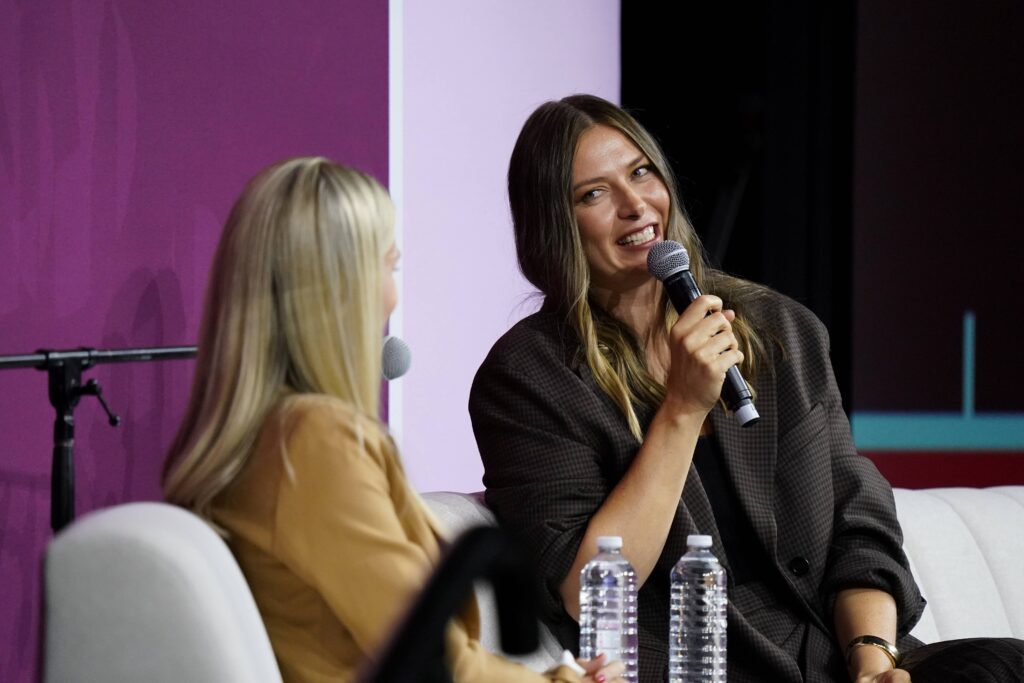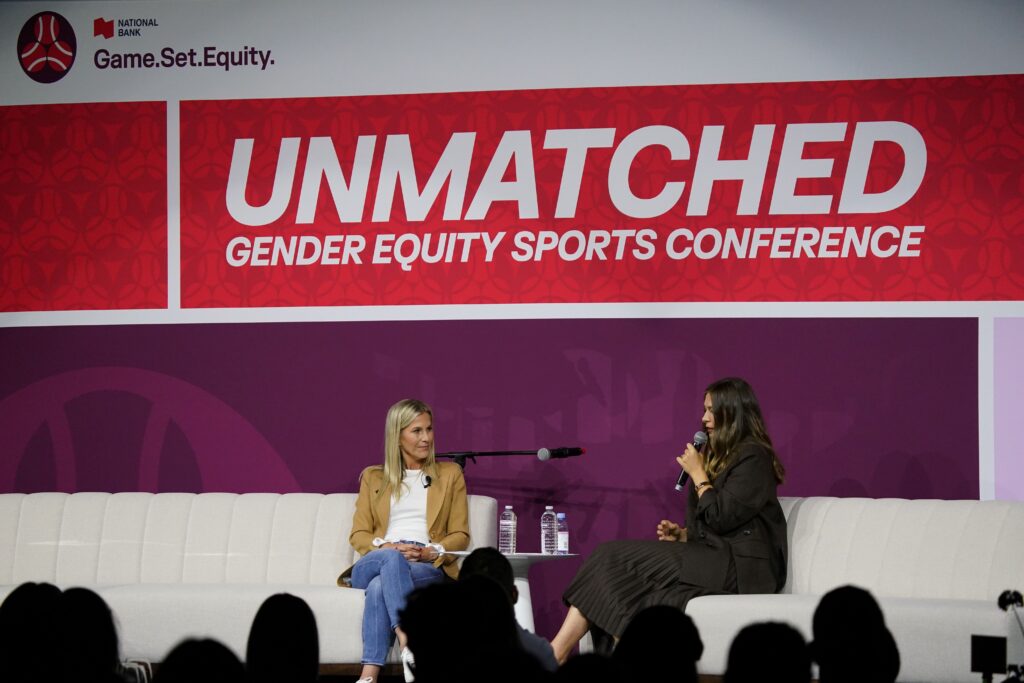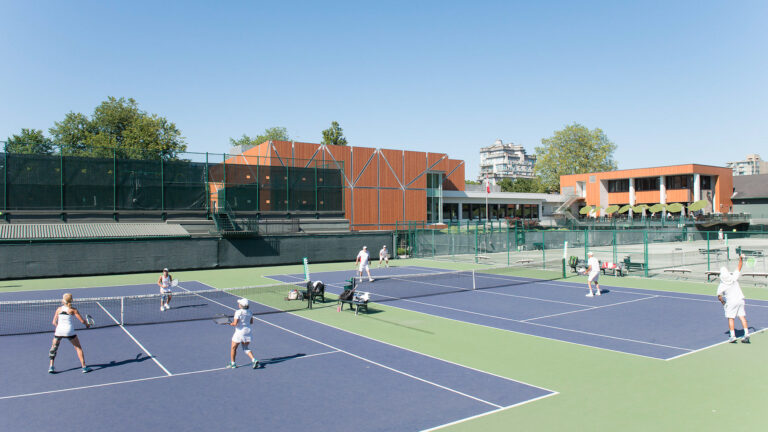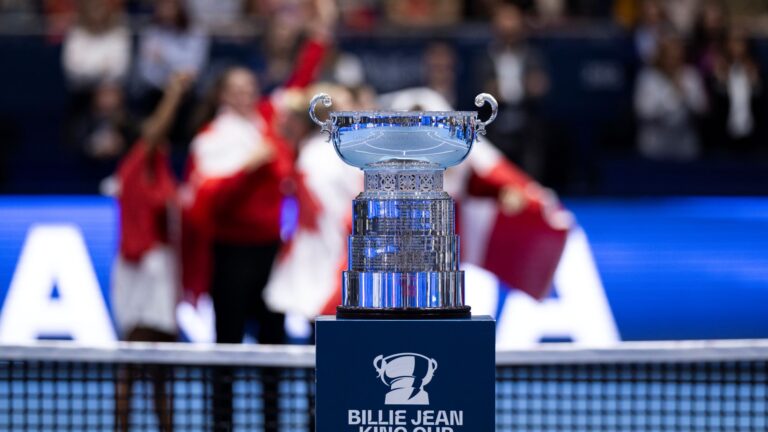
Photo : Max Gao
by Max Gao
It’s been three and a half years since Maria Sharapova retired from professional tennis, but the five-time Grand Slam champion recently came face-to-face with some former colleagues during an overnight trip to Toronto.
“I was in the hotel with some of the players and ran into some in the elevator, and they’re like, ‘What are you doing here?’ And I’m like, ‘What are you doing here?!’” Sharapova recalled with a laugh. “I didn’t know I was going to see so many players, so it was nice to be back in this atmosphere of seeing the athletes up close again.”
While the likes of World No. 1 Carlos Alcaraz were in town to compete at the 2023 National Bank Open presented by Rogers, Sharapova — who reached the final of the women’s event during her return from shoulder surgery in 2009, but admitted that she had struggled over the years to make the trip to Canada after playing at Wimbledon — was back in Toronto to speak at the second annual UNMATCHED: Gender Equity in Sports Conference.

“This is such a great way to meet people, interact with people, hear different perspectives, and I’m truly honored [to be here],” Sharapova told attendees at the Paramount EventSpace in Woodbridge on August 9. “I know last year Billie Jean King spoke, and I got a message from her partner, Ilana, last night: ‘Billie Jean was up on stage.’ And I was like, ‘Well, thanks so much. That’s a very tough act to follow!’”
In a wide-ranging conversation with Jennifer Bishop, a partner at Aird & Berlis LLP and executive board member at Tennis Canada, Sharapova spoke about the never-ending fight for gender equality in tennis, her transition away from the sport, and how she has been able to parlay her on-court success into becoming one of the highest-paid female athletes of all time.
A Different Kind of Arena
Sharapova burst onto the scene in 2004 when, as a 17-year-old, she defeated top-seeded Serena Williams to win her maiden Grand Slam title at Wimbledon. Sharapova’s victory not only shot her to global fame seemingly overnight but also made her one of the most marketable athletes of her generation, allowing her to ink lucrative endorsement deals with brands such as Nike, Porsche, Evian, Tag Heuer, Cole Haan, Tiffany & Co. and Canon throughout her two-decade playing career.
In addition to becoming the 10th woman to complete the Career Grand Slam, she was reportedly the highest-paid female athlete for 11 consecutive years, according to Forbes, and was among the first tennis players to earn the majority of her income off the court.
“When I gained success at a young age, I was genuinely surprised by how much interest there was in my life in every single lane,” said Sharapova, who has now navigated more than half her life under the public spotlight. “I’ve had to stand up for myself many times. It wasn’t popular to be more than just a tennis player — to be interested in fashion, to have your own line. You’re in this sandbox, and you’re not allowed to play with anything else. And I feel like in some ways, I wanted to disrupt that. I wanted to challenge my brain in other ways. I realized that tennis was a business vehicle for many opportunities. I wasn’t going to be fantastic at it, but I could be curious and I could learn about the future of sport and the future of business.”
Read also: A Love of Tennis is Growing the Game in Ottawa
For the former World No. 1, balancing the competitive and business sides of tennis was never 50-50. “You have to be okay with the fact that you’re not always going to be there for someone if you have a career that entails you to be on the road for 10-11 months,” she said. “But first and foremost, I knew the one thing I was strong at was tennis. So, from the moment I woke up, it was the one thing and the one accomplishment I wanted to get through and do my best at. And when that would finish, whether I’d just had one practice, two practices — when that was over, I could focus on other things.”
But that isn’t to say that Sharapova didn’t give her all on the tennis court. With her remarkable steel, talent and drive, the Russian made a name for herself as one of the game’s fiercest competitors, despite being plagued with recurring injuries that led to her decision to retire in February 2020.
“Toward the end of my career, I tried very, very hard to get my body back in shape and injury-free, and a lot of that came from my stubbornness because I truly believed I could repair my ligaments and my tendons in my shoulder just if I worked harder,” Sharapova said with a self-deprecating laugh. “And sometimes, you have to let go of that stubbornness in order for there to be more beautiful things in your life to open up.”
Read also: The Philpott Children’s Tennis Legacy Grows With Girls Recruitment Program
Since hanging up her racquet, Sharapova has taken on new challenges. She’s announced new brand partnerships, done more speaking engagements, and gave birth to her first child with the British businessman Alexander Gilkes — a boy named Theodore. Asked about the most challenging part of transitioning from sport, Sharapova said, without missing a beat: “Becoming a mother. I gained an entirely new respect for mothers and motherhood and giving birth, of taking care of this little creature.”
The Fight for Gender Equity
In 2006, Venus Williams, whom Sharapova describes as “an incredible inspiration” who “fought for female athletes and females in general from a very young age,” played a pivotal role in the fight for equal prize money at the four Grand Slams. “When I was exposed to that question and the subject, as a teenager, I didn’t really have a strong opinion because I wasn’t around that much,” Sharapova admitted.
“I didn’t quite understand why that was even such a topic, because I would wake up in the morning and just wanted to be the best version of myself,” she continued. “Ultimately, even though I have a deeper appreciation of what it means to be a female athlete, I look back at that and think, ‘It is about being the best version of yourself. It’s not about comparing myself to someone else or a male player or a match that’s three-out-of-five sets. It’s about trying to be better and trying to be a champion.’”

When the topic of equal prize money is broached in professional tennis, it’s usually discussed at the big events on the calendar — the Grand Slams, the Masters and WTA 1000 events. “And yes, 15-20 percent of the tour is equal. But where’s the rest of the 80 percent? It’s not even close to being equal,” Sharapova explained. “Unfortunately, those events don’t have the biggest media rights, they don’t have the visibility, so therefore, that subject of equality doesn’t even get a platform because not too many people know internationally [that] these tournaments exist.”
Read also: Andy Murray on Equality in Tennis
Although there has been “an amazing, tremendous shift” in the last five years, Sharapova feels that the evolving conversation about investing more in women’s sports in general “has been towards more leagues and teams, media rights and sponsorships, and not necessarily the individual female athletes,” who are attempting to build brands of their own during their time away from competition.
“When the focus is on the individual, it is more about what they’re saying on social change, on mental health — and less of who they are as a player and as an athlete,” Sharapova remarked. “When you look at the skill set that these athletes have, the athleticism, the competitiveness — that is [all] so special, and I don’t think enough of that is being seen and enough of that is being heard.”
Sharapova conceded that a return on one’s investment, at the end of the day, “takes a very, very long time” — and just because someone has enjoyed success in one domain doesn’t automatically mean it will translate to other walks of life.
“I trained almost 12 years on the back courts of different country clubs and public courts and private courts in order to get myself to Centre Court at Wimbledon,” she said. “As I go into a new chapter of my life, a lot of people — some of which are my friends — say, ‘Oh, you’re going to do so well. You’re going to be even better in business.’ And I say, ‘Actually, no. I’m not so sure because it took me over 10 years to develop this skill in one craft, to learn the ins and outs, to learn my technique, to get my mentality in place, to feel like I was ready to compete with these incredible athletes.’ So, in whatever chapter and lane that you’re in, it takes time to develop a skill set. It takes time to experience your emotions, to get through challenges, to overcome them and then learn and have a few more setbacks to feel grown up.”
Tennis Canada announced in June that the National Bank Open will offer equal prize money to women and men starting in 2027, two years after the tournament plans to adopt a 12-day main-draw format. Before Sharapova took to the stage at the UNMATCHED press conference, a short video — in which some top ATP Tour players declared their support for equal pay — was played for the audience. “But as we all know, actions are more powerful than words, so [the male players] need to lean in,” Sharapova said with a smile.
In fact, the tennis icon had a call to action for the entire audience: “If you’re attending a sport — let’s say it’s tennis, it’s the night session at the U.S. Open — and you’ve got the women starting at 7 p.m. and followed by the men, you show up at 6:55 and be there for the first point that they play. Don’t show up halfway through their match in order to watch the men. Show up for the women.”


